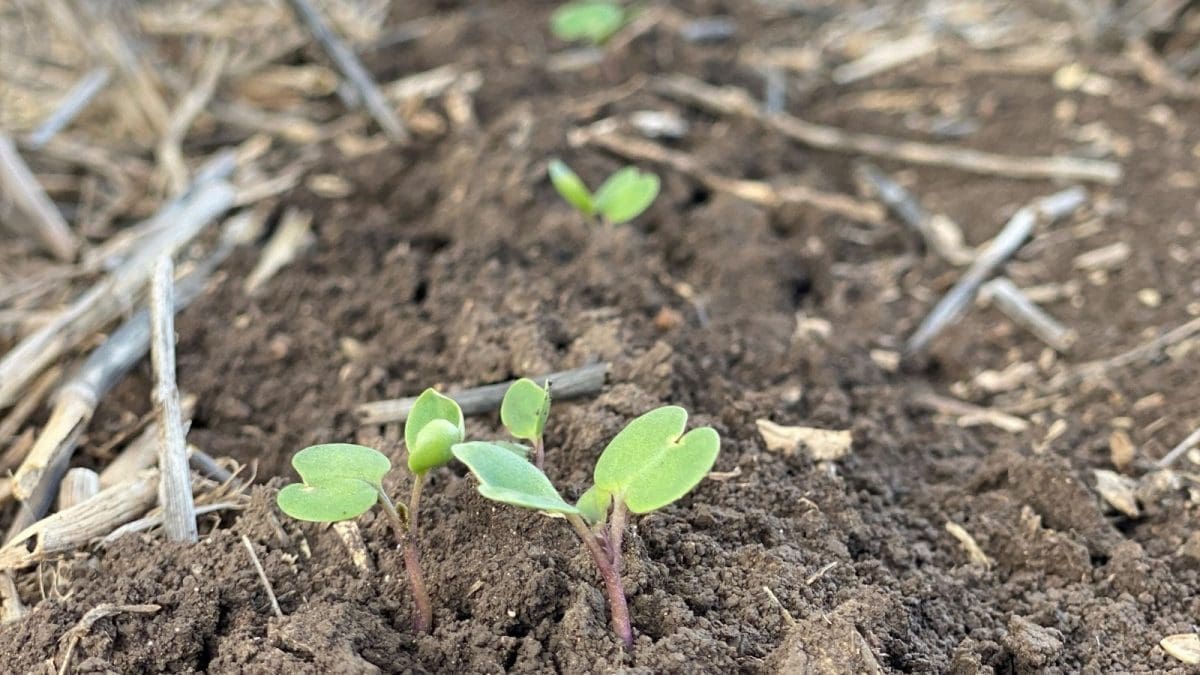
A crop of canola sown earlier this month at Breeza in north-west NSW. Photo: Pioneer Seeds
THE Australian Oilseeds Federation (AOF) has forecast a 2021-22 canola area of 2.9 million hectares (Mha), a national record bolstered by very strong canola prices and favourable conditions in Australia’s biggest canola-producing states.
In its May crop report released which includes its first new-crop estimates, area is seen as up 25pc on last year, and is 5 per cent below the standing Australian Crop Forecasters estimate.
With a decade-average yield applied, total harvest could exceed last year’s record of 4.3 million tonnes (Mt).
The 2020-21 crop delivered an above-average national yield, and if this were applied to new-crop area, would deliver a 5.3Mt crop.
Conditions mixed
AOF executive officer Nick Goddard said conditions for the crop are mixed at this early stage.
“Dry seeding in South Australia and the Wimmera, and the disruption to seeding due to mice in NSW, has tempered enthusiasm for a record crop,” Mr Goddard said.
Rainfall in the lead-up to and during seeding in NSW and WA was excellent, adding to already good soil moisture in NSW.
In contrast, SA and Victoria’s canola-growing areas experienced very dry conditions, which have improved only slightly this month.
“The strong demand did create issues of seed shortages, particularly for WA, which may have limited ultimate area sown.”
During late March and early April, much of NSW had above-average or well above-average soil-moisture levels.
“This triggered strong and early planting, with dual-purpose crops gaining in popularity and well established, with many grazed by mid April.
“However, drier conditions during the second half of April led to some seedbeds drying out, resulting on patchy establishment.”
Rain in early May helped struggling roots to access stored moisture.
In some cases where germination was delayed or staggered, mice have destroyed seed and crops either resown to canola if seed was available, or resown to other crops.
However, throughout most of the state, mice baiting has been very effective.

Table 1: Industry estimates for Australia’s 2020-21 canola crop, and initial estimates for 2021-22 crop incorporating figures from Grain Industry Association of WA, NSW Department of Primary Industries, and the Victorian Government. Source: AOF
Dry of concern
Victoria is yet to receive a general rain, particularly in the Wimmera and Mallee, to establish canola crops.
A warm and dry autumn has led to very low soil-moisture levels in these regions, with most seeding dry.
Most sowing to the end of April was in the North Central and North East regions, where sub-soil moisture was reasonable.
Mice baiting has been effective in retaining seed, even if germination was slow or delayed.
Once the seedling reaches the two-leaf stage, it appears mice are less interested in canola.
South Australia has experienced similar conditions to Victoria, and planting intentions were high pre-season, with a 20pc area increase on prior year.
This area could recede if the early May rain was insufficient to trigger effective and consistent germination and establishment.
Mr Goddard said very high prices for lentils have created some late changes to planting intentions, particularly in South Australia’s Mid North and Yorke Peninsula.
“Very high winds accompanied with above-average temperatures this week could also impact canola crops, with any damaged or lost crops potentially resown to lentils if there is rain in the next week or so.”
Ideal start for WA
WA experienced an unusually wet late summer and autumn, with tropical rain events from the north delivering 100-200 millimetres of rain in the canola-growing areas and creating decile 10 conditions.
With average rainfall forecast for the coming three months, WA’s canola crops are seen as well positioned to enter spring in a strong state.
“The favourable conditions combined with strong prices have seen areas planted exceeding records in many regions.
In its latest report, the Grains Industry Association of WA said new-crop canola area was up 20-50pc in the Geraldton zone, and up 20pc in some areas of the Albany zone.
Seed shortages have limited potential areas sown, especially in related to hybrid varieties.
At 1.5Mha, 2021 is the largest canola plant on record for WA, eclipsing the previous record set in 2017-18 by 11pc.
Source: AOF



HAVE YOUR SAY